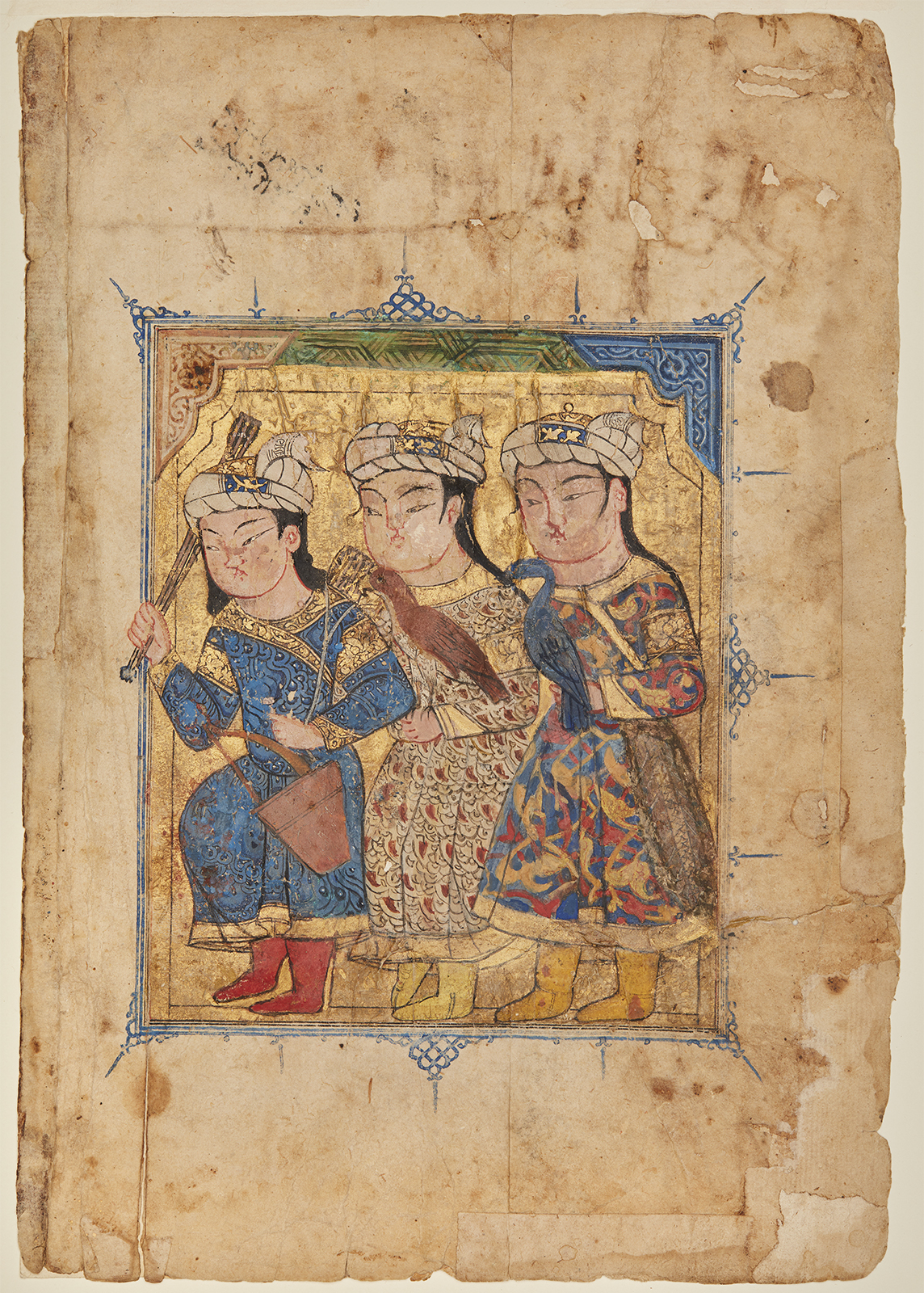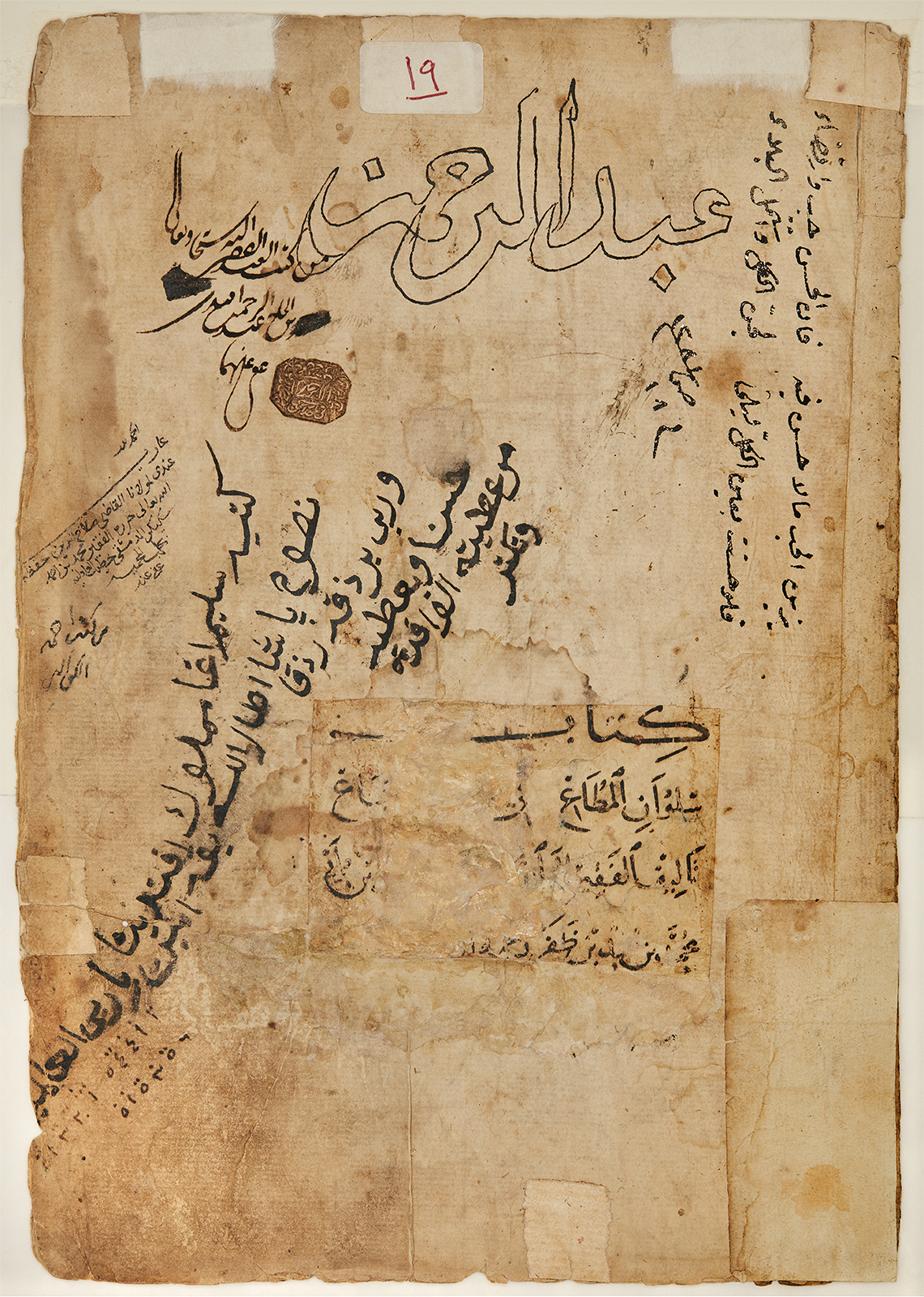Click on the image to zoom
Frontispiece
Folio from a manuscript of The Prescription for Pleasure (Sulwan al-Muta’ fi ‘Udwan al-Atba’) of Ibn Zafar al-Siqili
- Accession Number:AKM12
- Creator:Author: Ibn Zafar al-Siqilli, 1104 - 1170/1172
- Place:Egypt or Syria
- Dimensions:24.5 cm × 17.2 cm
- Date:ca. 1330
- Materials and Technique:opaque watercolour, gold, and ink on paper
The Sulwan al-Muta’ fi ‘Udwan al-Atba’ (The Consolation of Princes over the Hostility of their Subjects) was composed in 1159 by the polymath Ibn Zafar of Sicily. Using Qur’anic quotations, traditions of the Prophet Muhammad, animal fables,[1] and tales of historical princely figures to provide lessons on human behaviour and its consequences, the text was written as a guide for rulers (a literary genre known as “mirrors for princes”). Ibn Zafar dedicated the first edition of the Sulwan al-Muta’ to an unidentified ruler facing revolt, and the second edition to Abu’l-Qasim ibn Hammud ibn al-Hajar, an Arab Sicilian leader who was his patron. The text was modelled after Kalila wa Dimna of Ibn Muqaffa (d. 757) and is regarded by scholars as an indirect precursor to The Prince, the magnum opus of Renaissance Florentine writer Niccolò Machiavelli (d. 1527).[2]
Further Reading
This folio comes from the only known illustrated copy of the Sulwan al-Muta’, now dispersed in public and private collections across the world;[3] in its original state, the manuscript would have contained 114 folios and 30 paintings.[4] This painting is the right-hand side of the manuscript’s double frontispiece. It depicts three sumptuously dressed youths standing against a gold background. The youths appear to be readying themselves for a hunt, a courtly pastime in the medieval Islamic world: one youth holds a bow in a case as well as a bundle of arrows, while the other two youths have falcons perched on their arms. Following a convention of Islamic book illustration, in which manuscripts open with courtly scenes of a ruler and attendants, the facing page would have depicted an enthroned ruler. Such frontispieces were intended to reflect the princely patronage of deluxe volumes.[5]
— Michael Chagnon
Notes
[1] For the text’s animal fables, see Francesco Bellino, “Animal Fables in the Sulwan al-Muta’ by Ibn Zafar al-Siqilli,” Islamic Sicily: Philological and Literary Essays. Quaderni di Studi Arabi n.s. 10 , ed. M. Cassarino (Rome: Istituto per l’Oriente C.A. Nallino, 2015), 103–22.
[2] For concise overviews of Ibn Zafar’s life and the text of Sulwan al-Muta’, see R. Hrair Dekmejian and Adel Fathy Thabit, “Machiavelli’s Arab Precursor: Ibn Zafar al-Siqilli,” British Journal of Middle East Studies 27/2 (2000), 125–37.
[3] For this manuscript, see Duncan Haldane, Mamluk Painting (Warminster: Aris and Phillips, 1978); Assadullah Souren Melikian-Chirvani, Sulwan al-muta’ fi ‘udwan al-atba’: A Rediscovered Masterpiece of Arab Literature and Painting (Kuwait: Tri Publishing, 1985); Anna Contadini, A World of Beasts: A Thirteenth-Century Illustrated Arabic Book on Animals (the Kitab Na’t al-Hayawan) in the Ibn Bakhtishu Tradition (Leiden and Boston: Brill, 2012); and a forthcoming essay by Mounia Chekab Abudaya, originally delivered as a lecture, “Pearls of Wisdom: Paintings from the Sulwan al-Muta’, a Mamluk Mirror for Princes” (April 14, 2015).
[4] Personal communication with Dr. Mounia Chekab Abudaya, October 14, 2019.
[5] For medieval Arabic manuscript frontispieces, see Robert Hillenbrand’s “The Schefer Hariri: A Study in Islamic Frontispiece Design,” Arab Painting: Text and Image in Illustrated Arabic Manuscripts, ed. Anna Contadini (Leiden and Boston: Brill, 2007), 117–34; and “The Frontispiece Problem in the Early 13th-Century Kitab al-Aghani,” Central Periphery—Art, Culture and History of the Medieval Jazira, eds. Korn and M. Müller-Weiner (Weisbaden: Reichert Verlag, 2017), 199–227.
References
Bellino, Francesco. “Animal Fables in the Sulwan al-Muta’ by Ibn Zafar al-Siqilli,” Islamic Sicily: Philological and Literary Essays. Quaderni di Studi Arabi n.s. 10, ed. M. Cassarino. Rome: Istituto per l’Oriente C.A. Nallino, 2015.
Chekab Abudaya, Mounia. Forthcoming essay originally delivered as a lecture, “Pearls of Wisdom: Paintings from the Sulwan al-Muta’, a Mamluk Mirror for Princes,” April 14,2015.
Contadini, Anna. A World of Beasts: A Thirteenth-Century Illustrated Arabic Book on Animals (the Kitab Na’t al-Hayawan) in the Ibn Bakhtishu Tradition. Leiden and Boston: Brill, 2012. ISBN: 9789004201002
Dekmejian, R. Hrair and Adel Fathy Thabit, “Machiavelli’s Arab Precursor: Ibn Zafar al-Siqilli,” British Journal of Middle East Studies 27/2 (2000), 125–37.
Haldane, Duncan. Mamluk Painting. Warminster: Aris and Phillips, 1978.
Hillenbrand, Robert. “The Schefer Hariri: A Study in Islamic Frontispiece Design,” Arab Painting: Text and Image in Illustrated Arabic Manuscripts, ed. Anna Contadini. Leiden and Boston: Brill, 2007. ISBN: 9789004157224
---. “The Frontispiece Problem in the Early 13th-Century Kitab al-Aghani,” Central Periphery—Art, Culture and History of the Medieval Jazira, eds. Korn and M. Müller-Weiner. Weisbaden: Reichert Verlag, 2017, 199–227. ISBN: 9783954901982
Melikian-Chirvani, Assadullah Souren. Sulwan al-muta’ fi ‘udwan al-atba’: A Rediscovered Masterpiece of Arab Literature and Painting. Kuwait: Tri Publishing, 1985. ISBN: 9788885033108
Note: This online resource is reviewed and updated on an ongoing basis. We are committed to improving this information and will revise and update knowledge about this object as it becomes available.




